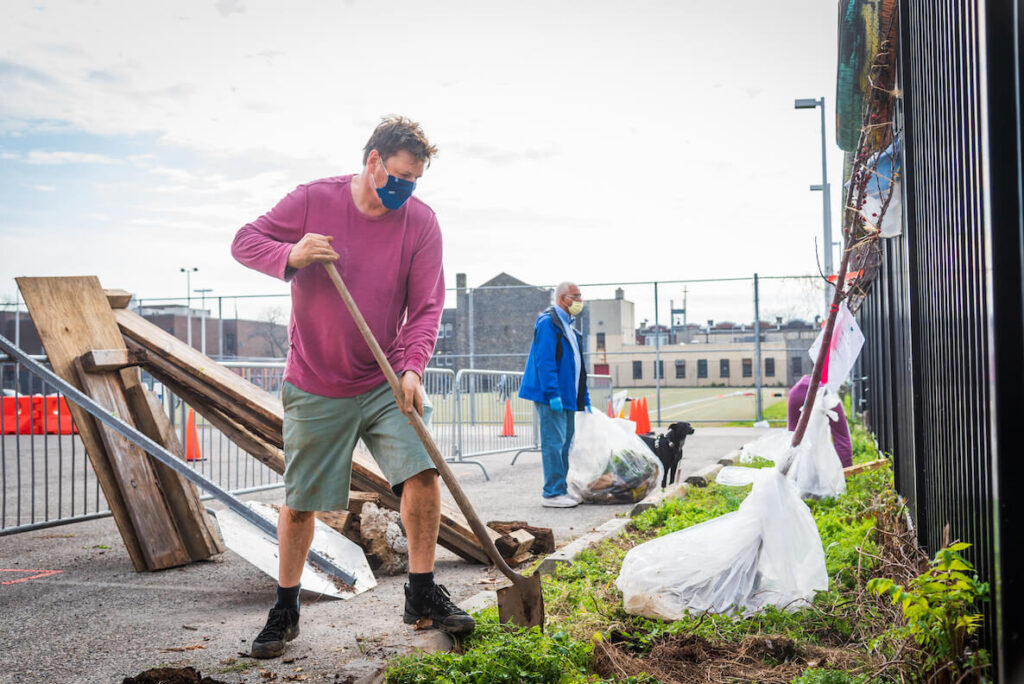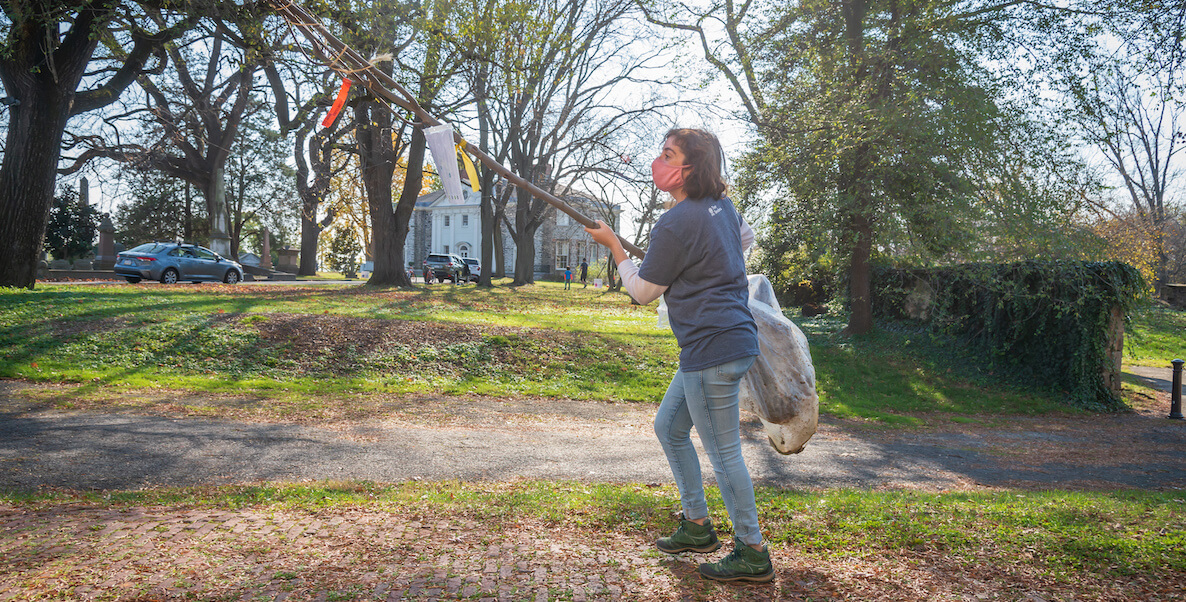There’s an 80-year-old Golden Elm tree on a busy intersection in Melbourne that is considered by the National Trust of Australia to be a “Significant Tree” at a state level—a designation that is, in itself, something to marvel at. But this particular Golden Elm tree has another claim to fame: It is also the most emailed tree in Melbourne.
This is how that came to be: Melbourne, in 2013, launched a state-of-the-art, publicly accessible tree map to provide citizens an easy way to alert the city to a street tree in need—overhanging branches, say, or trunks that are entangled in power lines. Every tree in the city’s Urban Forest Visual was given an ID number and an associated email to direct information to the right city agency.
“If people knew what species of tree was on their block, just that tiny bit of knowledge can contribute to how you see and value it more,” Ifill says. “It really is low-hanging fruit to get people to care.”
In the years since, though, Melbourne residents have taken to directly “treemailing” the trees—often with mash notes, as chronicled in an article in secretmelbourne.com:
“Hi tree on the corner of Punt Road and Alexandra Avenue and that little street that goes up the side,” says one writer. “I’ve always wondered about you ever since my slightly strange driving instructor (who always smelled like cat food and peppermints) told me you were his favourite tree.”
“Dear Tree,” writes another, “If you are that big round beautiful low hanging tree I think you are my favourite tree. Such beauty on such an ugly road.”
What may be even better than being able to email trees, is that they actually answer—or, at least, Urban Forest and Ecology Project Officer Giuliana Leslie does on their behalf. Leslie estimated last year that over 10,000 emails have been sent to Melbourne trees, some from all over the world.
It’s a testament to the power, beauty and urgency of urban foliage—and it is a reminder of what we lose when trees die or are pulled down. A Philadelphia resident encapsulated this idea last year, during a public outreach program with TreePhilly: “It’s like a scar, when [trees are] wiped out of a certain area or neighborhood.”
RELATED: “The Trees are the Lungs” city arborists in their own words
Working to protect the trees that already exist, while dramatically increasing the number we have, will be key recommendations in the city’s forthcoming PhillyTree Plan, a draft of which was released in November for public feedback until December 1. (Philadelphia Parks & Recreation’s Community Forestry Manager Erica Smith Fichman says the final plan should be released in the spring.) The ultimate intention of the 10-year plan is to increase our tree canopy, the amount of green covering the city as seen from above. The previous goal, laid out in the City’s 2009 Greenworks Plan, had been to reach 30 percent tree canopy in every neighborhood by 2025.
We are a long way from that goal. As of 2019, our tree canopy covered 20 percent of all city land—a 6 percent drop, equivalent to 1,000 football fields, over the prior decade. Even that coverage is uneven: As this New York Times analysis pointed out last June, Chestnut Hill, for example, has more than 60 percent of the neighborhood shaded by trees; in Nicetown-Tioga, only 6 percent is covered by trees. And temperatures in Nicetown—a redlined neighborhood decades ago—average 10 degrees higher than the wealthier neighborhood just five miles away. It’s the same story in cities all across the country, with richer Americans enjoying almost 50 percent more tree coverage than poorer Americans.
Trees are an incredible boon to households, neighborhoods and communities. But there is, also, something else: Beauty, and our responsibility to create and care for a more (literally) fruitful, attractive green landscape, for our current and future community’s health and well-being.
Trees are an incredible boon to households, neighborhoods and communities. Shade trees keep neighborhoods up to 20 degrees cooler in the summer, reducing individual energy costs. Their roots absorb water and reduce flooding, a growing problem. They purify the air, storing carbon dioxide. And they raise property values for all the houses on the street by about 10 percent.
But there is, also, something else: Beauty, and our responsibility to create and care for a more (literally) fruitful, attractive green landscape, for our current and future community’s health and well-being. Near the start of Rebecca Solnit’s beautiful book-length meditation on George Orwell, Orwell’s Roses, she chronicles the Nineteen Eighty-Four author’s love of trees and the caring of them, quoting from an essay he wrote in 1946 that celebrates the gift of trees to our future selves: “The planting of a tree, especially one of the long living hardwood trees, is a gift you can make to posterity, at almost no cost and with almost no trouble, and if the tree takes root it will far outlive the visible effects of any of your other actions, good or evil.”
RELATED: 5 ways to “rewild” Philly to revive the splendor of our natural enviorns
Philly has taken some important steps. In 2019, TreePhilly put out an environmental justice report that laid out a vision for increasing tree equity in the city. After years of advocating for funding, Philadelphia Parks & Recreation last year launched City Works, a nationally-recognized municipal software program that replaced the Excel spreadsheet it previously used to keep track of its trees. As of the end of 2021, Smith Fichman says her department now has a full, searchable inventory of street trees, and is on its way to an inventory of park trees, along with their status: risk of dying, pruning needs and the like. (This includes about 115,000 of the city’s 3 million trees.)
 And the Pennsylvania Horticultural Society’s 30-year-old Tree Tenders program has some 5,500 volunteers in the region, working to plant and care for trees, especially in the critical first couple years, when the baby trees are still getting established. Each year, PHS Director of Trees Tim Ifill says, Tree Tenders plant about 2,000 trees, though those are not all in the city. In the last several years, PHS has put a greater emphasis on helping underserved communities, both economically and horticulturally, develop Tree Tenders programs, as it did in Hunting Park, one of the hottest city neighborhoods with the lowest tree canopy. “They started from no Tree Tenders three years ago, to being one of the most active groups now,” Ifill says.
And the Pennsylvania Horticultural Society’s 30-year-old Tree Tenders program has some 5,500 volunteers in the region, working to plant and care for trees, especially in the critical first couple years, when the baby trees are still getting established. Each year, PHS Director of Trees Tim Ifill says, Tree Tenders plant about 2,000 trees, though those are not all in the city. In the last several years, PHS has put a greater emphasis on helping underserved communities, both economically and horticulturally, develop Tree Tenders programs, as it did in Hunting Park, one of the hottest city neighborhoods with the lowest tree canopy. “They started from no Tree Tenders three years ago, to being one of the most active groups now,” Ifill says.
The Philly Tree Plan will lay out various ways to increase and maintain the trees that line our city streets, looking at best practices, with an eye to equity and transparency. One idea, Smith Fichman says, will be to pay local residents in underserved areas to plant and care for trees—solving two needs at once—perhaps by expanding PowerCorps PHL’s paid training program or working through the Commerce Department’s Green Corridors program. Another is to increase communication and transparency about tree requests for all residents.
RELATED: Green City Works hires formerly incarcerated citizens to beautify their neighborhood
Deep in the middle of the draft Tree Plan is a recommendation that seems critical to its success: Creating an Office of the City Forester within Parks & Rec to coordinate all the tree-related activities. Under the current system, responsibility for trees is scattered among different departments, organizations and institutions—including Parks & Rec, PHS and Fairmount Park.
All of this is happening at what may be a uniquely ideal time: Although money specifically for urban forestry died along with the Build Back Better bill in Congress, both Pres. Biden’s infrastructure bill and the American Rescue Act have flooded the city with funds. How could those be used to build a city of trees we can all benefit from?
Ideas from around the world to increase Philly’s tree canopy
TAKE OVER THE SIDEWALKS
In Philly, as in many cities, sidewalks are peculiar strips of urban land: They are in the public right of way, but are owned and cared for by property owners. This leads to much of the hesitation around trees: It can cost thousands of dollars to fix broken sidewalks if tree roots break them. (Smith Fichman says TreePhilly has started pointing people towards a sort of insurance program from American Water Resources to help defray sidewalk costs.)

In Washington, D.C., trees have been part of street design since 1791, when architect Pierre Charles L’Enfant laid out the city, so there are legally-designated spots for trees that date back more than 200 years. And, because of a promise to federal agencies to plant more trees, city workers insist on planting saplings, rather than wait for a request from residents. Perhaps it is no surprise, then, that D.C. has one of the country’s best tree canopies, with a goal that seems maybe even attainable: The city’s plan is to go from 38 percent canopy to 40 percent by 2032.
As the city’s chief arborist, Earl Eutsler, told me a few years ago: “We overwhelm [residents] with trees. What we’ve noticed is that as people are increasingly surrounded by trees, they have a desire for more. There’s this tipping point where areas with very few open spaces clamor for things to be planted, and areas with no trees can go all year without one request.”
OR AT LEAST HELP PAY FOR SIDEWALKS
Both New York City and Cleveland have adopted programs to help residents pay for sidewalk damage related to new or old trees. In New York, residents can submit a request through 311 or the Trees & Sidewalks Program to have city workers inspect the site, rate its immediate need and either schedule a repair or advise residents on next steps. Cleveland’s 50/50 Sidewalk Residential Replacement Program splits the cost of repairs with residents while funding lasts every spring, something also adopted by the town of Fate, Texas.
MAKE TREE MAPS PUBLIC
Let’s say you’re a homeowner in Queens, and want to know the benefits, needs and other particulars about trees in your neighborhood. You’re in luck! New York’s publicly-accessible Street Tree Map is a detailed catalog of nearly 700,000 trees, including what type of tree, its address and, more interestingly, the ecological impact as calculated using formulas from the U.S. Forest Service. For example: The London plane tree near 39-84 45th Street, which the Map says intercepts 4,924 gallons of stormwater every year, conserves 2,245 kWh of energy, and removes 4 pounds of air pollutants and 6,841 tons of carbon dioxide for a total monetary benefit of $375.63. You can’t get much clearer than that.
Every city in every country in the world is contending with climate change; most are committed to planting trees. Let Philly be one that matches that goal with an actually funded commitment to do the work.
This sort of information can be key to helping people understand the importance of trees in our city. “If people knew what species of tree was on their block, just that tiny bit of knowledge can contribute to how you see and value it more,” Ifill says. “It really is low-hanging fruit to get people to care.” Right now, Philly’s tree index is only available to city workers with a City Works license.
But the roadmap for public access is already there: Several years ago, local geospatial software company Azavea used Philly as a pilot project for its Open Tree Map program, which it sells to municipalities. It fell out of use mostly for organizational reasons, Smith Fichman says, but now that the city has info about trees in one place, it could be time to revive it.
FOSTER A TREE ADOPTION PROGRAM
Once we publicly map our trees, we can do so much more. As highlighted in a Reasons to be Cheerful article last year, the city of Berlin launched an open source app in 2020 called Gieß den Kiez—“pour the neighborhood” that allows Berliners to adopt trees to care for. The app provides detailed information about each tree, including how and how often to water it. So far, more than 2,000 citizens have adopted over 5,000 trees, which has also saved the city of Berlin money: According to one of the program leads, it costs the city between 7 and 8 euros to water each tree.
LEARN FROM EACH OTHER

Closer to home, we can look to the work that Esperanza has done in Hunting Park, building off a two-year grant PHS helped them secure to develop a sustaining Tree Tenders program that is greening up a previously barren cityscape. Ifill says PHS is actively looking for tree deserts that have community organizations it can partner with to bring resources and expertise to the work of planting and caring for trees. One place to start is by becoming a Tree Tender by taking part in an 8 hour training session; the newest session started virtually last week, but is recorded via Zoom so Ifill says people can still sign up here.
PLANT MORE TREES—AND URGE THE CITY TO DO THE SAME
Why do we allow developers to cut down giant trees, as they did along Broad Street near Washington Avenue a couple years ago? Why are we not demanding they plant the trees they paint into their renderings? (The Tree Plan draft has some recommendations to push developers to do more on their part.) Smith Fichman says the Philly Tree Plan project team is still working out the budget for the various recommendations in the forthcoming Tree Plan, along with whom will be responsible for acquiring those funds. Every city in every country in the world is contending with climate change; most are committed to planting trees. Let Philly be one that matches that goal with an actually funded commitment to do the work.
As Orwell compellingly put it: “I am not suggesting that one can discharge all one’s obligations towards society by means of a private re-afforestation scheme. Still, it might not be a bad idea, every time you commit an antisocial act, to make a note of it in your diary, and then, at the appropriate season, push an acorn into the ground.”
Do I mean to imply we should consider the care of trees our personal penance for every less than stellar action we take as individuals and communally? Perhaps not. Then again, it can’t hurt.
The Citizen is one of 20 news organizations producing Broke in Philly, a collaborative reporting project on solutions to poverty and the city’s push towards economic mobility. Follow the project on Twitter @BrokeInPhilly.
![]()
RELATED
Reality Check: Could We Cut Philly Shootings by. . .Up to 93 Percent?
Header photo: PHS's Tree Tenders program has some 5,500 volunteers in the region | Courtesy of The Pennsylvania Horticultural Society




